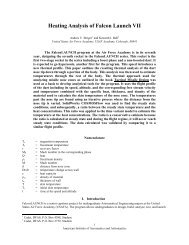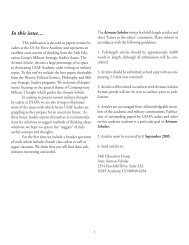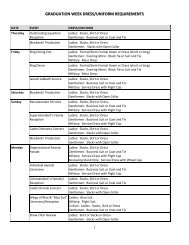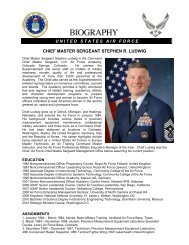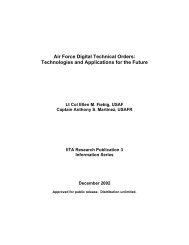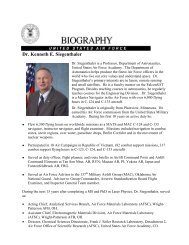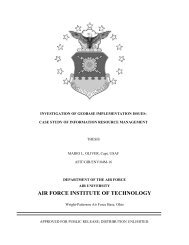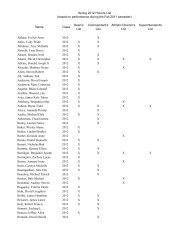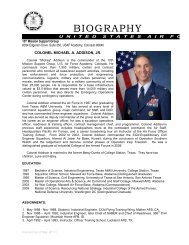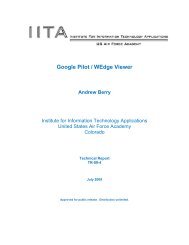the rollback of south africa's biological warfare program
the rollback of south africa's biological warfare program
the rollback of south africa's biological warfare program
You also want an ePaper? Increase the reach of your titles
YUMPU automatically turns print PDFs into web optimized ePapers that Google loves.
30 The Cassinga raid highlights <strong>the</strong> difficulties involved in verifying CBW<br />
incidents. The TRC concluded that this alleged use was developed under<br />
auspices <strong>of</strong> Project B. A report on <strong>the</strong> Cassinga attack was prepared by a joint<br />
UNHCR/WHO mission on 30 May 1978 and reproduced as Annexure V in<br />
UN document 13473 <strong>of</strong> 27 July 1979. However, observers who arrived 30<br />
minutes after <strong>the</strong> attack found no evidence <strong>of</strong> chemical weapons use.<br />
(Interviews with former SADF special forces <strong>of</strong>ficers and defense analysts,<br />
July 2000).<br />
31 Interviews with former SADF Special Forces <strong>of</strong>ficers, July 2000<br />
32<br />
Interview with Dr. G. Scharf, former Director <strong>of</strong> Medical Hospital One<br />
Pretoria, 6 July 2000.<br />
33 Interview with Gen. (ret.) Georg Meiring, Pretoria, 3 July 2000.<br />
34<br />
Interview with former Defense Minister Magnus Malan, Pretoria, 23 June<br />
2000.<br />
35 Interview with Gen. (ret.) Bill Sass, Pretoria, 12 June 2000. This rationale<br />
for developing nuclear weapons is <strong>the</strong> one most frequently mentioned by<br />
former SADF generals and some former politicians. For a fur<strong>the</strong>r discussion <strong>of</strong><br />
o<strong>the</strong>r rationales that have been provided by South African <strong>of</strong>ficials during and<br />
after <strong>the</strong> apar<strong>the</strong>id era, see Badenhorst (unpublished manuscript), Hounam and<br />
McQuillen (1995), Reiss (1995), and Stumpf (1995/96).<br />
36 According to Brig. Gen. (ret.) Phillip Schalwyk, South African forces in<br />
Angola received an urgent cable from UNITA commanders during Operation<br />
Savannah asking for help because <strong>the</strong>y had been attacked by Cuban troops<br />
who wore “pig face masks.” Interview, 12 July 2000.<br />
37<br />
Annette Seegers, The Military in <strong>the</strong> Making <strong>of</strong> Modern South Africa. (New<br />
York: St. Martin’s Press, 1996).<br />
38 Interview with Magnus Malan, 23 June 2000.<br />
39 Interview with Dr. Vernon Joynt, Pretoria, 14 June 2000. Dr. Joynt claims<br />
that Surgeon-General Nieuwoudt sent Major Wouter Basson to him in 1978<br />
and <strong>of</strong>fered him <strong>the</strong> directorship <strong>of</strong> a chemical weapons <strong>program</strong>. While Joynt<br />
refused, many scientists and specialists accepted research projects by<br />
Nieuwoudt and Basson, and many did not tell <strong>the</strong>ir superiors.<br />
40 Seegers, The Military. See also S.A. Watt, “The Anglo-Boer War: The<br />
Medical Arrangements and implications <strong>the</strong>re<strong>of</strong> during <strong>the</strong> British occupation<br />
<strong>of</strong> Bloemfontein: March-August, 1900,” Military History Journal Vol. 9 No. 2<br />
(August). South African Military History Society /<br />
military.history@rapidttp.com. (Accessed 15 June 2000).<br />
96




